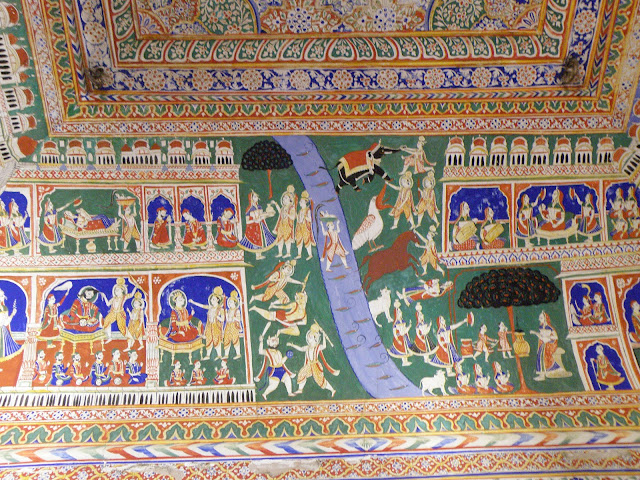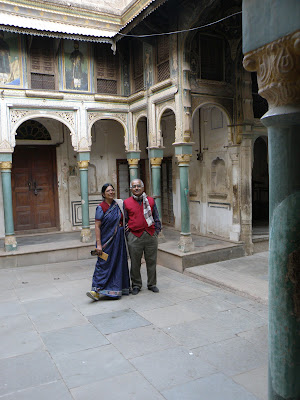A TRAIN on the walls of Nawalgarh’s Podar haveli or mansion set me free in December 2009.
Free to imagine how the semi-desert Shekhawati region’s painted mercantile
residences shone in the 19th century. Free to wonder at the magic of
restoration, renewing flaking frescoes for posterity.
Rita, a dear schoolmate from our Jaipur alma mater takes me to the Podar haveli on our last day in Shekhawati, before we drive back to the
Rajasthan capital, 180 km. southwards. Within the mansion turned museum, the
painted station with its train exudes creative energy. Each shuttered
compartment has passengers at the windows. Above it, an epic scene unfolds
horizontally. For Ramnath A. Podar chose to restore the wrought-iron verandah-fringed
outer walls by 90 per cent, the inner rooms by 60 per cent, illuminating their time-ravaged
natural pigments.
A scene from the epics at a Bissau haveli
Inspired by colonial rule...!!
Within the haveli,
through the baithaks or sitting rooms
with ornate hookahs and glass lamps, past arched passageways and courtyards, the
local fresco art celebrates the family fortune. Imbued with flat folksy
perspectives, interspersed with colonial elements, scenes unspool dramatically on
the walls – from Kurukshetra to Venice,
from the Rajasthani love story of Dhola-Maru to the Ramayana. These Podars, we learn,
are as lauded for their educational philanthropy.
The haveli gives us
much to mull over at lunch besides the delectable gatte ki sabji and ker sangri
at the stately Roop Niwas heritage hotel nearby, run by a local Thakur family.
The hotel promises camel safaris and horseback expeditions, offbeat choices beyond
the local taxi.
Between bites, we ask: If the Podars could re-ignite fresco
magic, why did the Sarafs of Mukundgarh or the Modis of Jhunjhunu distance
themselves from their havelis? What
untold stories teem through Shekhawati, through the bauris or stepwells, abandoned forts, temples and local bazaars?
The Krishna Leela as seen through an artist's eyes
What makes these natural pigments so luminous, even today?
Our fresco hunt that December takes us through Mukundgarh, Bissau, Alsisar,
Malsisar, and Nawalgarh from our base at the Jhunjhunu circuit house. From
these towns, besides Mandawa, Mahansar, Churu, and Dundlod, 19th
century Marwari merchant adventurers named Saraf, Modi, Kanoria, Murarka,
Tibrewal, Singhania and others, set out for Kolkata, Mumbai, Chennai, or
Karachi to seek their fortunes. Their now-abandoned Shekhawati havelis provide current clues to the
pulse of Indian business. Among their number are the legendary Kolkata-based
Birla family, originally from Shekhawati’s Pilani.
The brilliant walls take us back to our geography teacher at
school, who said, “The Thar desert provides
little to those who live off it. They toil with more ingenuity than people from
the green, fertile lands of Bengal or Kerala. The
desert scrub offers little colour. So, local people compensate with bright
colours for their clothing, or in their homes….”
This rings true of the Podar mansion. It is a stark contrast
to our first stop, the Saraf haveli at Mukundgarh. Under a bleached moon at
4.30 p.m., peacocks perch atop crumbling ramparts, as pigeons call from netting
over its cobweb-festooned dusty inner courtyard. Portraits of Indian freedom
fighters loom over the entrance arch, while niches safeguard scenes from the
Krishna Leela.
Even the ceilings are detailed with colour and imaginary scenes...
Street children, their hair sun-leached golden, follow us,
chanting, “Hello toffee!! Hello pain…!” What’s that? It translates to pen, we learn.
But we have neither to offer them. Do foreign tourists to this triangular
semi-desert belt between Delhi, Jaipur and Bikaner carry such gifts
in their backpacks?
From the circuit house, we explore Jhunjhunu’s bustling
Phootla Bazaar, in search of locally-crafted scissors, besides the Modi haveli.
Up a broad flight of stairs, its courtyard opens to the skies, is a crimson-rich
baithak embellished with mirrors. But
its carpets are threadbare, the air smells mothballed. The rheumy-eyed
caretaker has few cues about whether his masters will ever return.
After an uncomfortably close encounter with the local ostentatious
Rani Sati temple, Rita and I board a décor-rich auto-rickshaw post-dusk, seeking
the Jama Masjid and the Radha Krisha temple built by Capt. Henry Forester, a
Briton of notably secular tastes. Shadows stalk us, the only women on the
streets at that hour. At the masjid, a lone devotee man concentrates on namaz; while at the tranquil temple
under the pipal tree, a solitary worshipper is immersed in the arati.
But Shekhawati’s clarion call to the tourist remains thousands
of frescoes, scattered across hundreds of havelis. Did these Marwari traders
commission such painted scenes – reminiscent of the Pabuji phad cloth scrolls that the itinerant bhopas or minstrels of Shekhawati use – to share their adventures
with their families back home? Or to remind their Shekhawati neighbours that
though they lived austerely at their new trade bases, their worldly success was
marked by their grand havelis, including
some four-storeyed ones?
Lady at her toilette
Cuing into Mughal art, some havelis boast of geometric patterns and blooms. Beyond Indian
epics, wondrous colonial elements surge to the fore – firang soldiers and rosy-cheeked officials in a Bissau room among the char haveli, a quaint motor car on a fading wall, its driver primly
bowler-hatted.
Were these created by itinerant painters from Jaipur or the
local masons? No one knows. Using either traditional secco techniques on dry
walls, or fresco on wet plaster, their palette was rich with natural pigments –
lampblack for black, lime for white, saffron for orange, and so on.
Historically, Shekhawati was an important 14th
century trading post on the caravan route to Gujarat.
It was named after Rao Shekha, a Kachchawa clan chieftain in the 15th
century, whose descendents reached across the Aravallis after the decline of
the Mughals, aligning their fortunes with the Amber and Bikaner rulers. Following invasions by local
rulers, the British stepped into Shekhawati in the 18th century,
putting an end to the caravan route.
Whether restored or crumbling, these frescoes reveal unique
historic and social commentaries. Unless other owners pick up early cues from
the Podars of Nawalgarh, a prompt visit might dispel disappointment before the painted
legacy crumbles to desert dust.
Rita and her husband Harish in the courtyard of a haveli
If the Italian government can safeguard Michelangelo’s
frescoes in the Sistine Chapel zealously, must we lag so far behind?









No comments:
Post a Comment